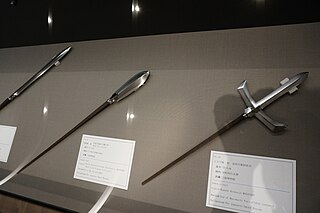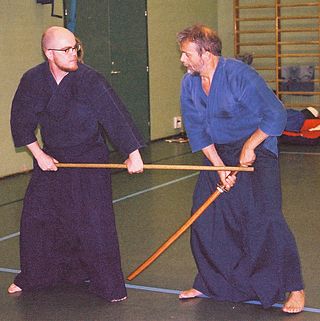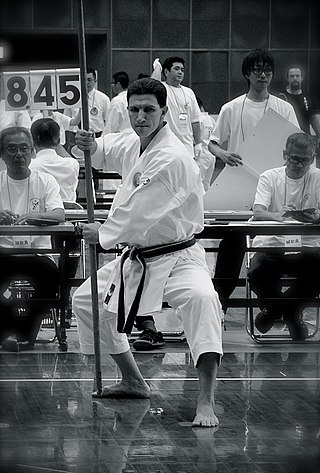
The nunchaku, "nunchucks", "chainsticks", or "chuka sticks" in English), is a traditional East-Asian martial arts weapon consisting of two sticks, connected to each other at their ends by a short metal chain or a rope. It is approximately 30 cm (12") (sticks) and 1 inch (rope). A person who has practiced using this weapon is referred to in Japanese as nunchakuka.

A shuriken is a Japanese concealed weapon used by samurai or ninja or in martial arts as a hidden dagger or metsubushi to distract or misdirect.

The tonfa is a melee weapon with its origins in the armed component of Okinawan martial arts where it is known as the tunkua. It consists of a stick with a perpendicular handle attached a third of the way down the length of the stick, and is about 15–20 inches (380–510 mm) long. It was traditionally made from red or white oak, and wielded in pairs. The tonfa is believed to have originated in either China, Okinawa or Southeast Asia, where it is used in the respective fighting styles.

Yari (槍) is the term for a traditionally-made Japanese blade in the form of a spear, or more specifically, the straight-headed spear. The martial art of wielding the yari is called sōjutsu.

Kobudō is a collective term for Japanese traditional techniques for the use of armour, blades, firearms, and techniques related to combat and horse riding. The kanji 古流武術 and 古武術 are other ways of writing it. The general umbrella term ko-ryū is also used to describe these ancient arts.

A bō (棒), pong (Korean), pang (Cantonese), bang (Mandarin), or kun (Okinawan) is a staff weapon used in Okinawa. Bō are typically around 1.8 m (71 in) long and used in Okinawan martial arts, while being adopted into Japanese arts such particular bōjutsu. Other staff-related weapons are the jō, which is 1.2 m (47 in) long, and the hanbō, which is 90 cm (35 in) long.

The sai is a pointed melee weapon originating from Okinawa. It is utilized in Okinawan kobudō, ninjutsu, and southern Chinese martial arts and is primarily used for stabbing, striking, parrying and disarming opponents. The sai consists of a pointed metal main prong, that projects from a one-handed grip, two shorter metal side prongs, which project from the opposite sides of the base of the main prong and point in the same direction as it, and a blunt metal pommel, that attaches to the bottom of the grip. It came to international attention, when martial arts became popular in the mid-20th Century, causing elements of Okinawan kobudō to spread to Japan and then to the wider world.

The nagamaki is a type of traditionally made Japanese sword (nihontō) with an extra long handle, used by the samurai class of feudal Japan.

Donald Frederick "Donn" Draeger was an American practitioner and teacher of martial arts. He was the author of several important books on Asian martial arts, and was a pioneer of international judo in the United States and Japan. He also helped make the study of martial arts an acceptable topic of academic research.

The kama is a traditional Japanese farming implement similar to a sickle or billhook used for reaping crops and also employed as a weapon. It is often included in weapon training segments of martial arts. Sometimes referred to as kai or "double kai," kama made with intentionally dull blades for kata demonstration purposes are referred to as kata kai.

Shintō Musō-ryū, or Shindō Musō-ryū (神道夢想流),a most commonly known by its practice of jōdō, is a traditional school (koryū) of the Japanese martial art of jōjutsu, or the art of wielding the short staff (jō). The technical purpose of the art is to learn how to defeat a swordsman in combat using the jō, with an emphasis on proper combative distance, timing and concentration. The system includes teachings of other weapon systems which are contained in Shintō Musō-ryū as auxiliary arts. The school is sometimes abbreviated as SMR.

Kusari-fundo is a handheld weapon used in feudal Japan consisting of a length of chain (kusari) with a weight (fundo) attached to each end of the chain. Various sizes and shapes of chain and weight were used as there was no set rule on the construction of these weapons. Other popular names are manrikigusari (萬力鏈) or just manriki.

Okinawan kobudō (沖縄古武道), literally "old martial way of Okinawa", is the weapon systems of Okinawan martial arts.
Kusarigamajutsu (鎖鎌術:くさりがまじゅつ) is the art of using the Japanese weapon kusarigama.

Isshin-ryū (一心流) is a traditional school of the Japanese martial art of kusarigamajutsu, the art of using the chain and scythe (kusarigama). Its exact origin is disputed, and may have been founded as early as the 14th century by the samurai Nen Ami Jion 念阿弥慈恩 (b.1351-?), but the modern-day techniques were compiled and incorporated no later than the 17th century, by the unification of Harayuki Uemon Ujisada (原志右衛門氏貞), hence the name. It is preserved in Shintō Musō-ryū as a "heiden".
A chain weapon is a weapon made of one or more heavy objects attached to a chain, sometimes with a handle. The flail was one of the more common types of chain weapons associated with medieval Europe, although some flails used hinges instead of chains.

The chigiriki (契木) is a Japanese flail weapon. It consists of a solid or hollow wood or iron staff with an iron weight and chain on the end, sometimes retractable. The chigiriki is a more aggressive variation of the parrying weapon kusarigama. It can be used to strike or entangle the opponent as well as to parry his blows and to capture or incapacitate an opponent's weapon.

Hōten-ryū (法典流) is a Japanese martial art founded in 1600 CE. It is a school founded on the use of the sword; however it has several different kobuki in its curriculum. It is also notable for its hidden weapons or items that appear to hide among everyday things.
Okinawan kusarigama is a rare chain (鎖) and sickle (鎌) weapon found in the Okinawan kobudō weapons set. A noted modern practitioner of the weapon was Seike Toma, a student of Chōtoku Kyan and a teacher of Seikichi Odo.
















